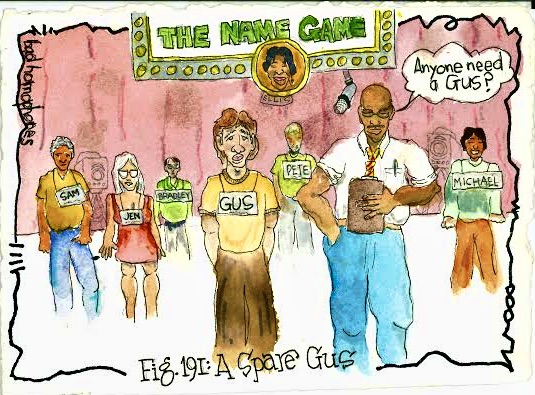Toledoan’s love of music leads to Over Yonder Concert House
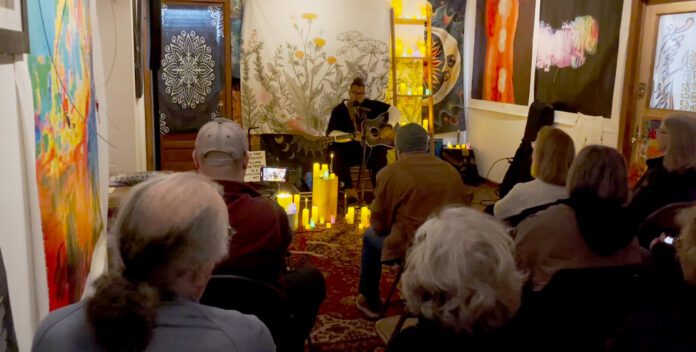
TOLEDO – What started out as a friend playing a concert in Rob Krain’s backyard in the Old West End has evolved into an ongoing series of intimate shows featuring a mix of local musicians and national touring artists.
“This has been a snowball rolling downhill,” Krain said after a February concert by Nashville-based singer-songwriter Crys Matthews. “I’ve always been a music fan, and I have friends in the music community. It started out just hosting them in the backyard, and then they told their friends, and their friends told their friends, and here we are.”
Krain said he used to have to drive to Detroit, Ann Arbor, Cleveland or Columbus to see his favorite bands, from folk and bluegrass artists to blues and rock musicians.
“I’d say, ‘I really wish this sort of music was in Toledo.’ And like anything else in Toledo, sometimes you just have to build it yourself.”
Krain founded the Over Yonder Concert House on July 16, 2016, with a concert in his backyard featuring his musician friend Eric Lambert performing on a small stage surrounded by a vegetable garden.
He and his girlfriend Jen Robertson have gone on to host more than 90 concerts since, including such noted artists as Jill Sobule, Jo Serrapere and Peter Mulvey.
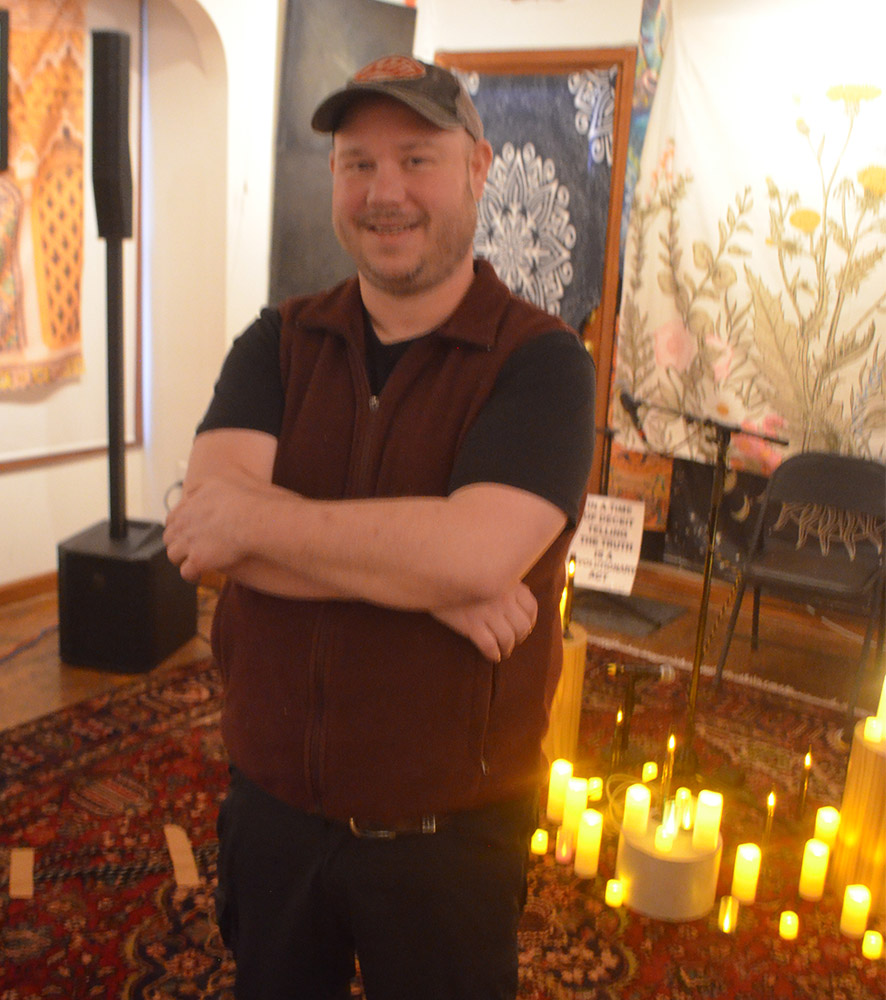
Krain said their goal is to host two shows a month, but he can have a hard time turning down an artist who asks to play an Over Yonder concert.
“We did over 25 last year, including a couple of months where we did four shows, and that’s too much for everybody. We had a family sit-down in November and we set some guidelines and boundaries. We’re doing less shows than last year.”
A lot of people think the Over Yonder name comes from a folk or blue grass term, but it actually was inspired by a rock legend.
“We have a red house,” Krain said. “And Jimi Hendrix has a song titled ‘Red House’ that goes, ‘There’s a red house over yonder,’ so that’s where we got the name.”
In addition to his love of music, Krain loves the Old West End community and seeks to bring neighbors together, as well as introduce other music fans to Toledo’s unique near-downtown neighborhood known for its many historic Victorian houses.
“We really try – no, I think we do – bring in phenomenal musicians, really talented artists. And it’s about building a community where they’re celebrated,” Krain said. “We have intimate shows and at the core of it, it’s about the music. It’s about building community around the music.”
A chalkboard sign at the entrance lets fans know what’s expected: “You are entering a listening room. Please silence your phone, refrain from talking during the performance, resist fascism. Thank you.”
“It’s just incredible,” said Robertson. “I’ve met so many amazing people who come to listen and be a part of the audience. And we’ve met so many incredible musicians. Just really neat people, really creative and just kind people, and they have a lot to say.”
Most performers stay at Krain’s and Robertson’s Old West End home, a few blocks from the where the winter indoor concerts are held. Their house is too small to host indoor shows, Krain explained.
Matthews, whose Feb. 9 concert marked the third time she’s performed an Over Yonder show, said she appreciates the vision and mission of Krain and Robertson.

“Rob is amazing. He’s wonderfully supportive of independent musicians,” Matthews said during intermission. “House concerts are so very important for community, especially in times like these. It’s important for the community to gather together, to know they’re not alone, and to have a place with a mission similar to mine is wonderful.”
Matthews, who described herself several times during the show as a “Black butch lesbian” and a “PK” (preacher’s kid), sings with authority and passion with lyrics that tackle racial prejudice and gender bias, promoting justice in all its many forms.
Displayed next to her was a sign that reads: “In a time of deceit, telling the truth is a revolutionary act.”
“I have a mission statement,” Matthews said. “To amplify the voices of the unheard, shed light on the unseen, and be a steadfast reminder that hope and love are the truest pathways to equity and justice.”
About 15 people attended her concert, sitting on metal folding chairs in a large room in a classic Old West End home on Scottwood Ave. The room was decorated with an eclectic mix of posters and artwork, including a flag on the ceiling that said, “Keep OWE Weird.”
The intimate atmosphere was enhanced by dimmed track lighting overhead and dozens of candles surrounding the performer.
“It’s my first time here and I think it’s a fantastic venue and a wonderful opportunity for people to hear live music and see it up close,” said Teri Bachman.

“I’m blown away by how good she is – her voice and the guitar work,” John Bachman said of Matthews. “We already plan on coming back.”
Admission was $20, and every dollar went to Matthews, along with all money from merchandise sales. That’s always the practice at Over Yonder, whose organizers and hosts don’t take a dime. Krain said giving artists 100 percent of the proceeds helps make Toledo a viable option for traveling musicians.
“It’s just a love for the music,” said Krain, whose day job is serving as director of the Black Swamp Conservancy. “I get to meet amazing people and become friends with people like Crys Matthews, and that’s all the value for me.”
All Over Yonder concerts are invitation-only, and anyone interested in attending one of the shows is asked to fill out a form online at Over Yonder Concert House.
For more information on Crys Matthews, visit CrysMatthews.com.
Special Report: LifeWise lobbies for nationwide legislation

Part 3 of a limited series about Ohio-based LifeWise Academy
TOLEDO – Recent changes to Ohio law mean all public school districts are now required to adopt policies governing religious release time (RTRI), setting the stage for battles over the language of these policies across the state.
The leaders of LifeWise Academy, the Ohio-based nonprofit pushing for Bible classes during public school hours, were major proponents of the legislation and are upfront about their goal to reach every district in the country with their programming.
LifeWise offers curriculum, coaching and other resources while local congregations provide financial support, classroom space and volunteers to help run programs. According to a state-of-the-ministry update in February, the program is live in more than 514 schools nationwide and serves more than 41,000 students. Adding the number of schools that are “confirmed” to launch next year, representatives estimated the program will soon be in 834 schools.
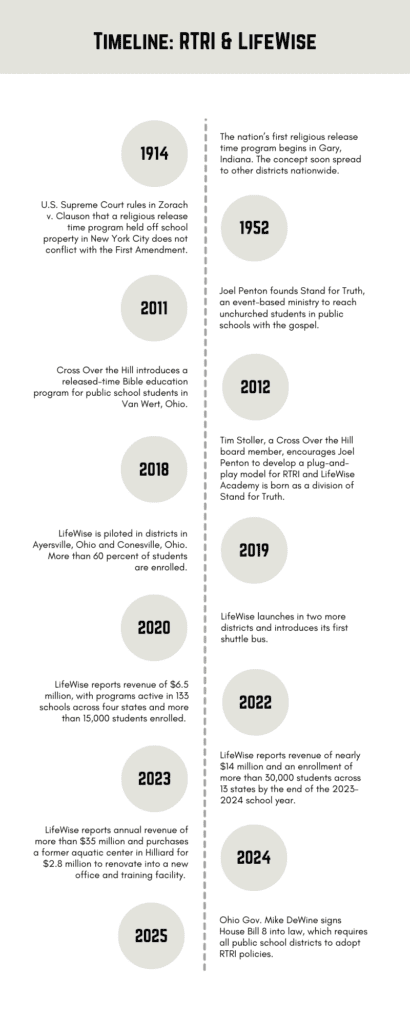
The legality of this arrangement is supported by a 1952 U.S. Supreme Court ruling that said students can be released from public school during school hours to attend religious classes. The Supreme Court stipulated that programs must meet off school property, be privately funded and can only be offered with parental permission.
Representatives from LifeWise were on hand to lobby for their cause at a December meeting of the National Association of Christian Lawmakers (NACL) in Scottsdale, Ariz. Founded in 2020, the group “is dedicated to uniting federal, state and local lawmakers in support of clear biblical principles,” and has members from all 50 states and Puerto Rico.
Following a presentation by Cody Balch, senior director of statewide initiatives for LifeWise, NACL members voted in support of adopting a model bill that would mandate public school districts adopt policies allowing religious release time. Similar to legislation passed recently in Indiana and Ohio, Balch cited the conservative Alliance Defending Freedom and First Liberty Institute as contributors to the bill. He referred legislators to the Released Time Resource Institute for more information.
There is no contact information on this one-page website, but a note at the bottom says the Institute was created by LifeWise “and other like-minded nonprofits as a contribution to the broader released time community.” It includes a map depicting the status of states with RTRI laws and links to downloadable model legislation and model school board policies.
Meanwhile, some advocacy groups opposed to LifeWise have developed their own model RTRI policies to address concerns about LifeWise disrupting the public school day.
Honesty for Ohio Education is a grassroots organization with a statewide coalition that includes state and local organizations, students, families, educators, legal professionals, healthcare providers, civic leaders and faith communities. Organizer Natalie Hastings said Honesty set up a working group to research LifeWise about a year ago after it came up as a common topic of concern in listening sessions with people around the state. The group includes an education law professor, current and past school board members and other partners from the coalition.
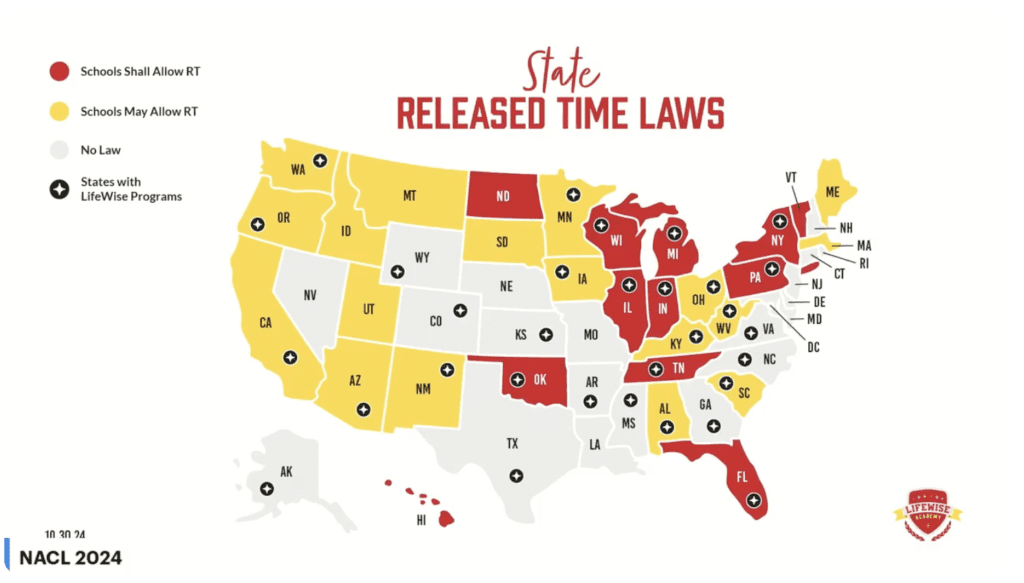
Last summer, the group produced an RTRI toolkit that included a model policy with suggested “guardrails” to protect students, such as mandated background checks, lunch guidelines, anti-harassment and anti-bullying policies and transportation standards.
Every point we bring up in that policy originated with a concern of something that happened at the local district level.
Natalie Hastings | Honesty for Ohio Education organizer
The model policy is a starting point for discussion of “reasonable things” to consider in RTRI policies, which Hastings noted would govern any religious group seeking to remove students during the school day, not only LifeWise.
Before this year, the Ohio Revised Code said public school districts “may” develop a policy governing religious release time programs. In January, Ohio Gov. Mike DeWine signed House Bill 8 into law, which changed that wording to say that districts “shall” adopt such a policy.
This means districts without an RTRI policy must adopt one by the time the law goes into effect on April 9. Districts that do not yet have such a policy will most likely be developing these in February so they can have a second reading and vote in March to meet the April deadline. “Over the next month will be a good reflection of what school districts end up incorporating from different policy suggestions,” said Hastings.
Districts prepare to comply with new law
As LifeWise programs have proliferated, some districts in Ohio previously responded by rescinding or choosing not to adopt RTRI policies. Last March, the Sylvania Board of Education opted not to develop such a policy after listening to a proposal for a Sylvania Schools LifeWise program. Board members cited concerns about liability, disruptions to the school day and opening the door to other programs requesting excused absences. They suggested it would be more appropriate to offer the program after school.
Dr. Veronica Motley, superintendent for Sylvania, wrote in an email to the Toledo Free Press that the Board of Education will move forward with formally adopting a policy to bring the district into compliance with the new law prior to the April deadline. There is a possibility of RTRI programs beginning prior to the end of the school year, she wrote, but depending on schedules and other logistics, they may not be implemented until next school year.
Sylvania Board of Education president Julie Hoffman did not respond to requests for an interview or further comment.
Another district that previously blocked LifeWise programming is Vermilion City Schools. The district serves about 1,700 students in pre-kindergarten through grade 12, and is located on the coast of Lake Erie, about 80 miles east of Toledo.


David Hile, Vermilion superintendent, and Wes Weaver, the district’s assistant superintendent and director of curriculum, were among hundreds who testified last year in the Ohio House and Senate to oppose changing the language surrounding RTRI policies. The two administrators drew on their own experience interacting with representatives of LifeWise in Vermilion.
Hile said he made it clear from the beginning to the pastors who presented the idea to him in 2023 that he would not be in favor of a program that pulls students out during school hours.
“Since the pandemic, only about half of our kids are reading on grade level by the end of third grade. So we have kids that are significantly behind in reading and math,” said Hile. “We don’t have an hour to spare in the school day to just let kids go do religious instruction.”
Weaver recalls the initial meetings with local pastors as being cordial, and the administrators offered to work with LifeWise on setting up an after-school program.
That conversation went well, but it became evident after they went back to the LifeWise people that they just weren’t going to have that,” said Weaver. “The point is pushing into school, during school hours.
Wes Weaver, Vermilion assistant superintendent and director of curriculum
LifeWise representatives attended several meetings of the Vermilion Board of Education, and board members listened to stakeholders on both sides of the issue for months before unanimously deciding not to move forward with adopting a district RTRI policy.
“They did exactly what you want local government to do,” said Hile. “They talked to everybody, they listened to everybody, and then they made a decision that represented what they felt like was best for the community.”
LifeWise representatives did not seem to accept that decision, according to Hile. Local supporters continued to contact the board and district administrators to advocate for the program, and they held a screening in December 2024 of a film promoted by LifeWise that claims to expose “the historical removal of the Bible from public education.”
Hile accuses LifeWise of being disingenuous in some of its claims, such as a flyer posted to social media that stated LifeWise Academy reduces the achievement gap by more than 50 percent. When he asked LifeWise for evidence of that, he received no proof to back up the claim.
Hile said he studied the achievement gap as part of the dissertation for his doctorate. “First of all, there’s not just one achievement gap, there’s multiple. And it’s usually based on race and socioeconomic status,” he added.
“And nobody has found a way to reduce the achievement gap, virtually at all. If you come in two, three years behind in kindergarten, which is when the achievement gap begins, schools have an incredibly difficult time making up those lost years, because we’re only in school for a year at a time,” Hile noted.
Hile also said Buddy Workman, a LifeWise field representative for North Central Ohio, falsely claimed at a spaghetti dinner for Vermilion’s LifeWise program in 2023 that the superintendent had refused to meet with him. Emails show that Workman never requested a meeting with the superintendent prior to this event.
Hile expressed frustration with the mandate to adopt a religious release time policy, which he views as overriding local control. “That to me is anti-democratic,” he said. “Why have a local school board if we’re going to be told by the state about everything we have to do?”
He said Vermilion will come into compliance with the new law after the board and administrators review the recommendations recently released by Neola, an organization providing educational policy guidance to schools. Hile has told LifeWise organizers next school year is the earliest a religious release time program could start in Vermilion.

Promoting character education or Christian nationalism?
Hile and Weaver both associated the push for LifeWise programming with Christian nationalism in their testimonies and in comments to the Toledo Free Press.
“They want to infuse Christianity, or the notion of Christianity, into our public schools, and be able to say ‘Look, we brought the Bible back to our schools. We brought Christianity and religion back to our schools,’ ” said Hile. “The problem is, it’s not Christianity, in general. It’s a very specific viewpoint of Christianity. And it’s not inclusive.”
While LifeWise Academy is not affiliated with any one Christian denomination, its website says its teachings align with “historic, orthodox Christian beliefs.” The LifeWise curriculum is based on The Gospel Project, which comes from Lifeway Christian Resources, an entity of the Southern Baptist Convention.

Critics of LifeWise say that its teachings discriminate against people who are divorced, unmarried and single parents, practitioners of non-Christian religions, and members of the LGBTQ+ community, including people who are transgender and couples in same-sex marriages.
“The idea that it’s kind of nondenominational and kind of neutral among all religious points of view, that doesn’t bear scrutiny,” said Weaver.
Responding to the LifeWise talking point that the program brings needed character education into public schools, Weaver asserted that public schools have always been one of the two main sources of character education for kids, with home being the primary one. “It’s baked into everything that we do,” said Weaver.
“The truth is, you can look to religion or spirituality or your faith for that sort of thing. That doesn’t mean that’s the only source for that, and the idea that removing a child from school for an hour a week is going to make them turn out better in terms of their character — there’s no evidence to support that,” said Weaver.
Ohio SB 56 passed by the Senate

The bill holds Ohio’s cannabis industry hostage
In 2023, Ohioans voted to legalize adult-use cannabis, anticipating economic growth, job creation and increased tax revenue. However, on Feb. 26, the Ohio Senate passed Senate Bill 56 (SB 56), a measure that threatens to undermine this potential by imposing restrictive regulations that could stifle the burgeoning industry.
The bill now moves to the Ohio House of Representatives and, if approved, will head to Gov. Mike DeWine’s desk for final approval.
Rather than addressing real concerns, SB 56 serves as a ransom note to Ohio’s cannabis industry—politicians are fully aware of the economic promise of adult-use cannabis, yet they are using unnecessary regulations and excessive taxation to hold that promise hostage.
Ohio’s cannabis market: Billion-dollar industry in jeopardy
Economic projections for Ohio’s adult-use cannabis market are substantial. BDSA, a cannabis market intelligence firm, estimates that combined medical and adult-use sales in Ohio could reach $1.65 billion by 2027. Industry analysts suggest the market could eventually grow to $4 billion, aligning with per capita sales in Midwestern states like Michigan.
However, SB 56 introduces major obstacles to this growth by imposing unnecessary restrictions, including:
- Increasing the cannabis excise tax from 10 percent to 15 percent, making Ohio’s tax structure one of the highest in the midwest.
- Reducing the number of home-grown plants from 12 to six.
- Placing limits on THC concentration in legal cannabis products.
- Eliminating the social equity program, which was designed to reinvest tax revenue into communities most impacted by past cannabis prohibition.
These changes not only disregard voter intent but also create a hostile business environment that will drive consumers to other states. Looking at other midwestern states provides insight into what Ohio stands to lose if SB 56 is enacted.

Michigan, with a population of 10 million, legalized adult-use cannabis in 2019 and has since collected over $1 billion in tax revenue. Cannabis tax revenue supports schools, roads and local governments, demonstrating the tangible benefits of a well-regulated market.
Missouri, with a population of 6.2 million, generated $1.4 billion in cannabis sales within two years of legalization—outpacing many states with older programs.
Ohio’s population is 11.8 million, meaning its cannabis market could be even larger. However, SB 56’s strict marketing rules, high taxes and excessive regulations will make Ohio’s cannabis more expensive than in midwestern states, like Michigan and Missouri. This will only push consumers to Michigan, where cannabis is cheaper and more accessible.

Ohio SB 56 is a solution in search of a problem
Supporters of SB 56 claim that additional regulations are needed to prevent societal harm. However, there is no evidence that adult-use cannabis legalization has caused a negative societal impact in Ohio or other states. In fact, research from multiple studies, including those sponsored by the National Institute on Drug Abuse (NIDA) and the Journal of the American Medical Association (JAMA), shows that:
- Youth cannabis consumption has not increased in states where cannabis is legal. Studies show that teenage cannabis use has either remained the same or declined post-legalization.
- Arrests for cannabis-related offenses have decreased significantly, allowing law enforcement to focus on more serious crimes.
- Cannabis legalization has not led to an increase in violent crime, contradicting claims from opponents of legalization.
Despite this scientific evidence, Ohio lawmakers continue to push the same outdated “Reefer Madness” rhetoric, painting cannabis as a public health threat while ignoring the well-documented dangers of alcohol, which kills thousands of children and young adults every year through alcohol poisoning, impaired driving and related accidents.
Conclusion: SB 56 must be stopped
The Ohio Senate’s passage of SB 56 last month represents a blatant attempt to undermine the will of the voters and weaken the state’s economic potential. The bill now moves to the Ohio House of Representatives, where lawmakers have the opportunity to reject this misguided legislation. If it passes the House, DeWine will have to decide whether to support Ohio’s economic future or cave to baseless fear mongering.
Ohio has the chance to create one of the strongest cannabis markets in the midwest, but SB 56 threatens to send consumers and tax revenue elsewhere.
Lawmakers must vote against this bill to protect Ohio’s cannabis industry, honor the will of the voters, and ensure that Ohio does not fall behind while other states thrive.
A REVIEW: The Last Showgirl
No Oscar nomination .. but thumbs up anyway
Had you told me at any point in the last x-amount of time that Pamela Anderson would give a fantastic performance in a narrative feature directed by Gia Coppola, a descendant of the Coppolas … well, I guess I wouldn’t quite know how to decipher that information.
Not that Anderson wasn’t capable of the work; she was a prime target of a stereotype for her time. Do you remember the ’90s? She was a typecast from the get-go: The buxom blonde running alongside David Hasselhoff in Baywatch, the trophy rockstar wife and prized fantasy of many early-internet lumps who spent hours fidgeting with AOL.
Had she been given the chance to shine in a serious role, it wouldn’t have made a dent, save for the gossip columns taking her to task for even trying. Does Barb Wire even count? She was doomed out of the chute, never given the chance to actually show her talent.
If she had filmed a few good roles and fallen into character roles, as is the usual arc for show business, her performance would be adorned with the tired acclaim of “She’s a revelation” or “Her performance is a resurrection.” Boy, do people love throwing those phrases around without knowing where they will land.
Joke’s on them. Anderson’s performance in the The Last Showgirl, a 2024 drama film written by Kate Gersten, is worthy of such praise, without the “Oh hey, where did you go?” pretense. You finally get to see Anderson act her ass off in a prime role.
Anderson’s character, Shelly, is the last member of a once-prestigious Vegas showgirl act, clinging to the past as the show is canceled after 30+ years. She has nothing to fall back on, thanks to ignoring Father Time. Her motherly advice to the younger dancers is follow the tales of her glory days.
But nostalgia doesn’t pay the bills.
Yet, it’s that nostalgia that keeps Shelly coming back and has been all these years, even as her facade of reality crashes and she’s left to sift through the detritus.
She can’t pronounce her estranged daughter’s name during a desperate phone call; her costume snags in the next night’s show; her knees buckle on the way to the stage the night after; and she’s given the “old timer” treatment by the younger roster.

All the while, she has Annette (played by Jamie Lee Curtis in a scene-chewing performance) as her mother hen. Annette was a former head of the show-line but became the jaded Casino cocktail waitress covered in fake bronze who chain-smokes, boozes and spits pearls at the youngsters.
Curtis nails her role. As the cantankerous stateswoman, she bites into her cigarettes and stares bullets into a past she refuses to talk about. Especially with Eddie, the showrunner played by Dave Bautista.
His role was a weird case. He was miscast, but I liked what he brought to the character. The character would’ve been easy to turn into the hackneyed club owner trope. At best, you’ll get Ben Gazzara in Killing of a Chinese Bookie.
Bautista goes in the opposite direction, portraying Eddie like a dog giving you the innocent (but guilty) eyes. He can’t look up, and any time he’s scolded, he always looks away.

But all tracks lead back to Pamela.
Great work eclipses the hands to whom the little golden statue is gifted. Anderson’s performance walks the thin line between child-like wonder and lashing out at what’s left when the curtain falls on her character.
You can tell she’s done her homework. Her performance blends the right mix of childlike wonder and the refusal to give in to her seeping reality. I was reminded of Ellen Burstyn in Alice Doesn’t Live Here Anymore, Mickey Rourke in The Wrestler, with a touch of Naomi Watts in Mulholland Dr. Anderson has cited Barbara Loden’s Wanda as a massive influence as well.
Is ‘The Last Showgirl’ a great film? The film didn’t receive a single Oscar nomination, but time, as always, will be the judge. I believe 20 years is the right amount of time to pass and to come back to an argument in full view.
Is Pamela Anderson’s performance terrific? I’ll put 10 toes in the ground and say “Yes,” despite her best actress nomination snub.
Stinky skunk cabbage emerges
Mother Nature doesn’t pay much attention to winter weather advisories.
She’s already preparing for the arrival of spring. Though winter may look silent and frozen, there’s new life stirring under the snow and ice.
In the forest, the layers of fallen leaves are a nurturing blanket. Already, the first new growth of the year has emerged and is pushing through that blanket. If it hasn’t already, it will soon flower and announce its presence with a mildly unpleasant odor.
One up-close whiff and you’ll know why it’s called skunk cabbage, even though it’s not a member of the cabbage family, and it doesn’t smell like a skunk.
The plant is uniquely suited for survival in the coming weeks of winter weather, even providing an organically heated sheath to protect its flowers.
Look for it along small streams, and in the sloughs and seeps of the Oak Openings Region.
Collingwood Arts Center to host annual burlesque shows

TOLEDO – Many forms of dance performance have toed the line between art and smut, but none compare to burlesque. The midwest’s love-hate relationship with the glamorous and sultry shows has resulted in crowds of performers moving in and out of cities, and with venues going in and out of business. Toledo is no exception.

Burlesque has a storied home in the Glass City. Most famously, it was host to Town Hall Burlesque Theatre, a venue operational in the late 1960s. Madamed and founded by Rose La Rose, an accomplished burlesque performer who earned her fame at the infamous New York venue Minsky’s, Town Hall was classy.
However, its original intention of creating luxury shows, like Minsky’s, was short-lived. Soon, adult films made their way into the theatre, its purpose changed, and it was demolished in 1968.
Today, burlesque shows are hard to come by in the city. The Collingwood Arts Center is changing that. The arts center recently hosted a speakeasy event, advertising burlesque performers. I witnessed a packed house, with multi-genre burlesque performances and the brooding atmosphere of a speakeasy.
The arts center plans to make the event an annual occurrence, a silver lining for performers like Morris and Worley, both of whom seek to land in more venues around the Toledo area. But can the negative assumptions about burlesque be changed? Jess thinks so.
The Victorian building has a lived-in atmosphere, transporting us to another time as I was led down a long, dark hallway in the basement of the Collingwood. Within an entirely black room, decorated in a classic burlesque theatre motif, there was a cash bar and Al Capone’s Vault (stacked with lottery tickets for a lucky winner).

Ruby Jade, Ada Atomic and Gina Arnez took the stage and wowed the audience with bumps, grinds and reveals. The audience generously handed out tips and wooed at their moves.
Jess Worley said the only place she’s seen burlesque performed in Toledo is the Collingwood Arts Center at the Speakeasy event. “It was incredible and I love the venue.”
The Toledo native has been a burlesque performer since 2021, though her performances have been restricted to Detroit because of the lack of demand for the art in our city. It’s been her mission to establish it here.
Worley has performed her routines at venues, like Detroit’s Northern Lights Lounge, Planet Ant and New Dodge Lounge. She has described her acts as fitting into two genres.
“I do a lot of classic, glamorous burlesque, but I do more nerdlesque recently,” she said. Nerdlesque refers to performers dressed as glamorized characters whose routines are filled with comedic tease and suggestion.
Worley’s version had the crowd rolling. Donning a token Guy Fieri flaming button up, wig and mustache, she flaunts on top of a giant, plush cheeseburger to a great track.
“My friend mashed the songs together for me, a hip-hop song called ‘Guy Fieri’ and ‘Cherry Pie,’ of course,” Worley said.
If anyone takes props and costuming seriously, it’s burlesque performers. Worley’s cheeseburger prop made from a large ottoman was lovingly crafted by her and her dad on Father’s Day.
The performers at the Speakeasy were no different.

Gene Morris, whose stage persona, Gina Arnez, dons a sparkling boa, said he wouldn’t call himself a burlesque performer. “I’m more of a female impersonator. When I started, people started telling me I reminded them of Liza Minelli, so I began doing her cabaret numbers.”
Morris is a Collingwood Arts Center advocate and has performed at several of their fundraising events. Although the act’s debut was on the main stage, this was the first performance of Gina’s in the underground theatre. “It was a really well-organized event and a lot of fun. The attendance was the best I’ve seen, the room was packed.”
Gina Arnez, winner of Mrs. Amateur Great Lakes 1999, has been dancing around Toledo for some time.

“I’m originally from Morgantown, West Va. I moved to Toledo in ’94 for a job. I met my current husband, David, when I moved up here, and we’ve been together for 30 years now – married 11. We used to go to Caesar’s Show Bar all the time for a night out and I said well, I’d like to try that. I was 36 at the time and that’s kind of late to start performing, but he encouraged me to do so.
“When I’m on stage a lot of people don’t recognize me. When I’m not presenting as Gina, I’m quiet and reserved. When I’m on stage as Gina, I’m a completely changed person,” he explained.
“Burlesque has a bad reputation; a majority of people associate it with strippers. Yes, but it’s an art form. It’s not for the male gaze – it’s for the female gaze. I don’t make my costumes for the men. I make them for the girls, gays and theys. It’s about rebellion and protest, this is my body and I’m going to show it how I want to.”
The crowds at the Collingwood Arts Center’s Speakeasy event are a testament to the demand of bringing burlesque back to Toledo. Although we may never see another exclusively burlesque venue like Town Hall, venues like the arts center are vital, living hubs for these forms of expression.

